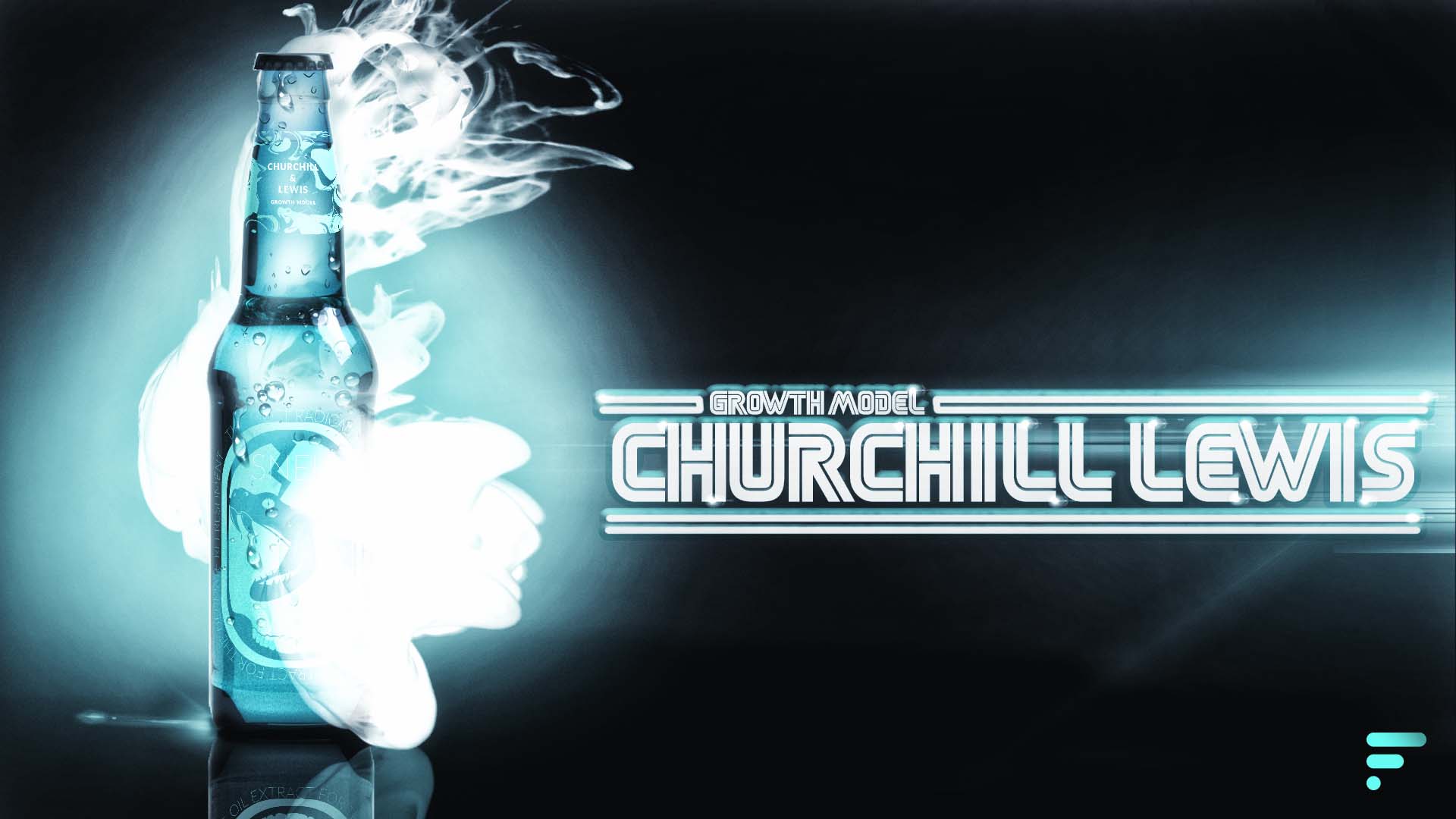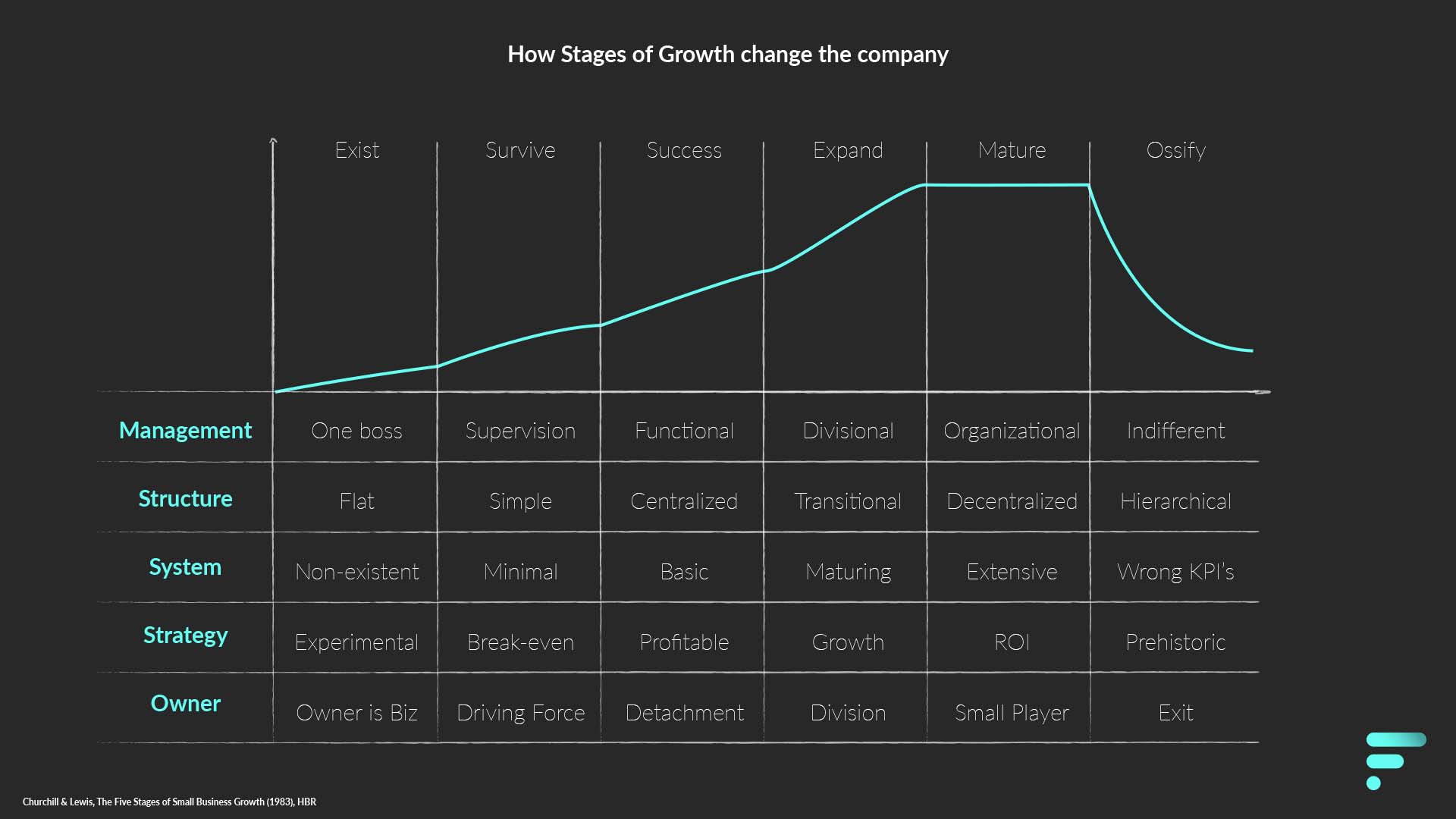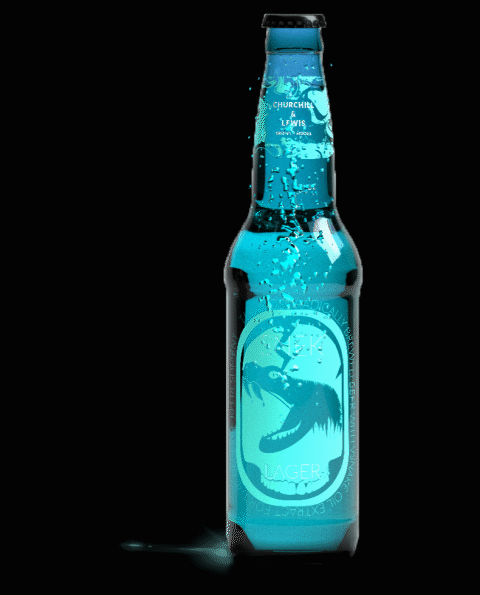Growth Model for Small Bussiness
Churchill and Lewis Growth Model

The Churchill and Lewis Growth Model is a model designed for small businesses. By recognizing the "stage" the company is at, the managers are better able to predict problems in the future and anticipate solutions.
Growth Model
The endless amount of work and the unforgiving environment where an entrepreneur has to maneuver to get an inch of success, can be devastating for anyone. Pair that with the crude reality of resource limitations and you have enough ingredients for entrepreneur drop-out.
Some may get around resource limitations, if they are brave or persistent enough to accept the conditions that go with it. The persistent will continue to gallop around, trying to figure out how to market the company and its products or services. Continuity will form the baseline. That baseline may convert to modest success. Later, expansion may even be an option.
There are not many companies whom are able to go from zero to one in one swift swoop. Small businesses will vary greatly in how fast they are able to grow. Moreover, the capacity and capabilities of entrepreneurs vary a lot as well.
Whenever you talk to an entrepreneur, you will quickly realize that they all go through similar hurdles. Most of the companies go through the same painful problems as any other company. There is no denying that some may overcome struggle faster than others. However, the stages they go through are overall similar.
Despite these hurdles being important in becoming more efficient, it can also quickly form a roadblock for an entrepreneur. Stopping them in their tracks and forcing them to think about aspects they would have preferred to deal with at a different stage. Or not at all.
However, throughout the different stages of an organization tough decisions need to be made. Without commitments or investments, growth is theoretically impossible. To secure one’s continuity it is important to make these decisions with a little bit of foresight. Imagine a fresh entrepreneur renting an office space. If they expect to grow really quickly, they may go for a bigger or central location to attract new staff members. On the other hand, if the entrepreneur misjudged the growth, they may be stuck with the contractual obligations of renting a place above their means.
Because these decisions or problems are so frequent a model was developed to provide a bit of insight. The model is called Churchill and Lewis growth model and when you know in which part of the model your company belongs to, it should provide insight in which direction you need to move during tough decisions.
The Churchill and Lewis growth model is generally used for small businesses. It is important to understand with this model that the owner is an important actor whom owns the majority of the shares during most part of the company’s existence (this is necessary to understand the intrinsic motivation of the owner and by extension the company).
So what exactly can you use the Churchill and Lewis growth model for? It should help you assessing in which stage a company is at. This will allow you to better understand where resources should be focused on and plan the overall growth of a small company. Consultants and accountants generally use the growth model to position a business and anticipate problems it may encounter and look for solutions before problems arise.
During this exercise we will be looking at the six different stages in the model: existence, survival, success, expansion (take-off), resource maturity and ossification.
Churchill and Lewis Growth Model
Let’s start with why the growth model is important. If you happen to be an entrepreneur, it helps to understand that you are not alone with the problems you have. You do not face only the problems you may have. As a matter of fact many have failed at a hurdle before yours and many more will fail after. The model helps you to evaluate the options available in a more global perspective. See it as a tool that gives an helicopter view. The growth model will not help with day to day tasks though, that will still be up to the entrepreneur.

Well, in reality it was never developed as a sentimental tool to help you overcome problems, but there is some comfort to be found in that every entrepreneur has to overcome similar hurdles.
Important in the growth model is to understand the stage you are at. The stage is defined by the age of the company and the complexity of the company.
Now the growth model gained traction after a publication in 1983. Arguably, age is not as an important factor as it was back in the mighty eighties. You could interchange age either by experience or know-how.

Once you have figured out the stage the rest of the chapters should give you a bit of insight what is important during those stages.

Existence
The stage of existence is the first. It is the stage in which the business has to prove it has the right to exist and that there is enough demand for its product or service to be existent worthy.
Getting clients and delivering the product or services to clients is crucial during this stage. It should be the sole focus of the company.
A garage may not be the most glamorous place to work at, but the job of the entrepreneur is to deliver. Delivering and delighting clients is the way to go. The rest is in most cases unimportant.
Moreover, it is the stage that is most difficult for an entrepreneur. Not only because the entrepreneur and the business are one in identity, but also because it is tough to overcome hardships that come with developing new products or service. You see, an entrepreneur puts all its blood, sweat and tears into making something successful which can lead to different problems that are more emotional by nature, like for example leadership. Employees (in many cases family) are generally managed flatly and there is little to no structure.
As inconvenient as it may sound, it is also the most difficult stage to get funding because the business has not proven itself.
Not only is the company the baby of the entrepreneur, gaining all the commitment and attention, but the entrepreneur wears blinders to gallop through all the problems it will encounter. Galloping to success is most certainly necessary, but during this stage the entrepreneur is also a business. Negating the business aspect can lead to dire situations as the finances needs to be kept in check in order to secure operation.
If the entrepreneur is able to fulfill all its commitments, the company will promote to the next stage. If not, be it by the entrepreneur not being passionate anymore about the business or the commitment it requires, the entrepreneur will want to create a plan to disinvest and see if he/she can cash-in on the investments made. Worst case scenario the entrepreneur will need to face bankruptcy.
The right of existence can also be explained with an example which we will continue to develop throughout the different stages:
In Amsterdam there are many small breweries that started with a single idea of creating a crafts beer that they really like. A beer they want to share and drink together with friends.
As with many of these stories, the craftsmen started in their house. They set-up the equipment and experimented relentlessly with their brews.
The first good batch was made. They bottled it and they are ready to share with their friends. After testing it with friends and the positive feedback they get hyped.
They start to believe they can actually make some money with it. Without the craftsmen knowing it, the company has already started, it is not a hobby, and the company is operating at a loss.
Survival
When a business reaches the survival stage it has proven its right to exist. There is a client base willing to purchase the goods and there is an opportunity to grow further. The concept has proof that it will work out.
It is during this stage that a balance needs to be found between costs and revenues. This step normally focuses on profitability and cash flow. To survive, the entrepreneur needs to break-even as soon as possible and start reserving liquidity for investments at a later stage.
Cash-flow is equally important because if payment for services or products are overdue, it can generate a negative cash-flow that the business may not be able to cover. Leading to bankruptcy.
Furthermore, the survival stage is also one of the steps that some businesses stay indefinitely. Categories that fall into it are generally restaurants, beauty salons or night shops and even manufacturers whom are unable to turn profitable enough to go to the next stage. You will recognize these companies because they are constantly struggling to survive and have problems with the limitations of their resources.
Structurally the company is simple. The owner takes most decisions and the company will begin to show more signs of structure. The employees still follow the orders of the owner. This can lead to problems of autonomy, because a company is not only developed by one single person (even if they strongly believe they are responsible for its existence).
The companies in this stage that are not able to go to the next stage have a few options. Accept that there is little reward for a large amount of effort or finalize the company. By finalizing they can either attempt to exit (sell) or cease to operate further.
Returning back to our brewery case example. The craftsmen have decided to quit their day job to work full-time at making beer at home. There is some cash reserved and there is some profit to be made from the sold beer.
Working at home making beer may not seem very glamorous, but the craftsmen are happy. However, while looking at the finance, they realize that they barely make enough money to survive. As a matter of fact, they realize they are working for under the minimum wage.
The craftsmen need to either decide to be happy with what they have, or perhaps nurture growth by renting the overcapacity of a bigger brewery.
Success
The third stage is where the business enjoys modest success by securing a steady stream of profit. The company is self-sufficient and has secured its position in the market where it seems stable and profitable. However, it is during this step that the owners need to make a crucial decision on how to continue forward.
The owner needs to decide by this stage to reap the rewards (be it by exiting or accumulating the profits) and pursue other activities. Or continue to invest the profit in the company.
Noteworthy though, is that during this stage is when the company starts to professionalize. More capable staff is hired and the decision is distributed between managers. Moving the decision making process from the owner to other staff members, frees up time for the owner whom is confronted with what route to take.
If the owner wants to reap the benefits and place control mechanisms to make sure the business sails smoothly into the profit horizon, the owner can expect to get returns for the foreseeable future. When things do not go as great the company will either fall-back into survival or an exit plan will be executed.
On the other hand, the owner can also decide to fully invest in the company. It will use all the resources gathered, maybe even external, and invest it in the growth of the company. In most cases this will be an all-or-nothing scenario in which it either succeeds or fails. When this decision is made the company will need to stay as profitable as possible to fund further growth. As is with the other decision, when things do not go as planned it will enter the survival stage or may even be sold during distress.
If you would like to know more about how to secure existence beyond the present, make sure to check the Three Horizons of Growth article.
Going back to the brewery example. The craftsmen decided to rent overcapacity of a competing brewery.
They made a financial assessment and they realize it is distressing to start a brewery on their own. Quickly they realize they are at the mercy of the brewery they are renting the capacity from.
However, they are making enough profit that it is not an immediate problem. The craftsmen stopped making beer themselves, instead the brewery is making the beer according to their recipe. Sales seem stable and the market share is stable as well.
The craftsmen have a pretty good life, however, they do not know what to do. Expand or just reap the benefits that came from a few years of hardship?
Expansion (take-off)
Expansion (take-off) is characterized by an effort to grow very rapidly or fail very rapidly. The problems encountered during this stage are growth and finance related. To grow you need to have enough capital, otherwise you cannot fund growth.
Moreover, when the company grows there are many pains that come with it, among them creating bureaucratic system in an effort to control the company. With expansion the company is bound to get more complex. Delegation is an important part of this process and the detachment of the owner from the business is necessary as the organization needs to be decentralized and divisionalized.
When the owner is not able to detach and is not able to further fuel the growth of the business it generally stops growing. The owner needs to realize that there are limitations to ones capacity. When this is not recognized there is a high chance the company will meet its demise sooner or later. On the other hand, if the owner is not capable enough to manage the expansion, but is aware enough of his/her own limitation, it may be able to sell its stake at a profit or appoint more capable managers.
As mentioned before funding does become a primordial part during expansion. With funding the owner will generally have to sell equity to investors. This results in investors having something to say when things are not going according to plan and can even discharge the owners (CEO). It is during this period that the owner can lose control as the majority shareholder.
When the company fails to expand, it can try to stop expansion and leave things as they were before. They may also drop to the previous step or even fall to the survival stage.
Returning to the brewery example. The original owners have been offered a substantial amount of money by the brewery it was working with.
The reason why the brewery is offering money is because they see potential in craftsbeer.
The owners understand that the brewery have all the systems in place to be able to expand the business. In return though, the brewery wants to be majority shareholder. The owner agrees to it as it sees it as a way for his initial vision of sharing a drink with friends to multiply.
However, the craftsmen are with this deal, no more majority shareholder. Losing control of the company. Because of the deal the company has grown so fast that it is hard for the founders to fill in the different positions.
One founder has entered the actual role of CEO and has to negotiate and justify the strategy and approach the company wants to take.
Resource Maturity
After making big leaps and growing exponentially there comes a moment where a company either plateaus, because there is nothing more to conquer, or there is no more money left for expansion.
Either way, it is during this stage when the company will be looking internally to consolidate the revenues earned and control them. More mechanisms will be put in place and everything will be as professional as it will ever get. Extra layers of management, strategic planning, risk analysis and many other systems have been developed to protect the ecosystem the business has carefully crafted throughout expansion.
The CEO will try to keep the company as lean and flexible as possible in order to anticipate changes in the market. However, it is during this stage that the financial resources, size and talent will make any company complacent as they can feel invincible and have overcome most complex situations.
In the case of the brewery, the company that started once as a craftsbeer has become an household name.
There is nothing magical anymore about the beer, it can be acquired anywhere and there is abundance in its consumption. It has become a commodity.
Ossification
When a company becomes complacent, avoids risk and uses its size as a tool to continue business, there comes a time when they become irrelevant when the market environment changes.
If a disruptor enters the market and catches a giant snoozing, they will need to start the old boiler. When a business becomes blinded by its own size, it can result in a giant being incapable of competing with a new generation of survivalists.
Normally during this stage, the company is large enough that it can buy the threats outright, but not everything can be bought. Since innovation is nearly non-existent during the ossification stage, a company can become stiff and lose market share and become obsolete by the time the survivalists become successful.
Generally when a company is down this path, it will merge with other companies.
In the case of the brewery, it has stopped developing new craftsbeer since the survival stage. It has lost touch with what made them special at the beginning.
In order to change the tide, they try to do the same trick as they went through: buying out a company in the success stage. However, the market has spoken, and the brewery is seen as obsolete and no new business wants to work with them.
The brewery will enter the survive stage.

Share this Page
References
Churchill, N. C., & Lewis, V. L. (1983). The Five Stages of Small Business Growth. Harvard Business Review.
Veldmand, H. (2016). Export Management. Noordhoff Uitgevers.



